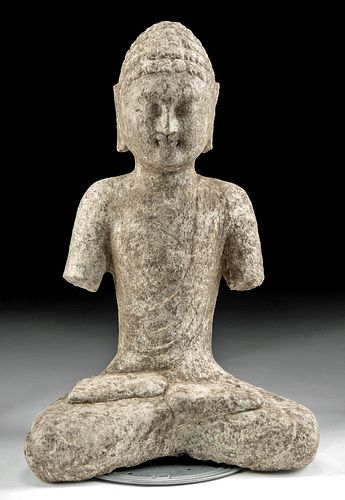Chinese Qi Dynasty Stone Seated Buddha
Lot 157a
About Seller
Artemis Fine Arts
686 S Taylor Ave, Ste 106
Louisville, CO 80027
United States
Selling antiquities, ancient and ethnographic art online since 1993, Artemis Gallery specializes in Classical Antiquities (Egyptian, Greek, Roman, Near Eastern), Asian, Pre-Columbian, African / Tribal / Oceanographic art. Our extensive inventory includes pottery, stone, metal, wood, glass and textil...Read more
Categories
Estimate:
$9,000 - $13,500
Absentee vs Live bid
Two ways to bid:
- Leave a max absentee bid and the platform will bid on your behalf up to your maximum bid during the live auction.
- Bid live during the auction and your bids will be submitted real-time to the auctioneer.
Bid Increments
| Price | Bid Increment |
|---|---|
| $0 | $25 |
| $300 | $50 |
| $1,000 | $100 |
| $2,000 | $250 |
| $5,000 | $500 |
| $10,000 | $1,000 |
| $20,000 | $2,500 |
| $50,000 | $5,000 |
| $100,000 | $10,000 |
| $200,000 | $20,000 |
About Auction
By Artemis Fine Arts
Jun 10, 2021
Set Reminder
2021-06-10 10:00:00
2021-06-10 10:00:00
America/New_York
Bidsquare
Bidsquare : Exceptional Antiquities | Asian | Ethnographic
https://www.bidsquare.com/auctions/artemis-gallery/exceptional-antiquities-asian-ethnographic-7012
Museum-worthy examples of Egyptian, Greek, Roman, Viking, Near Eastern, Far East / Asian, Pre-Columbian, African / Tribal, Oceanic, Native American, Spanish Colonial, Russian, Fossils, Ancient Jewelry, Fine Art, so much more! Artemis Fine Arts info@artemisgallery.com
Museum-worthy examples of Egyptian, Greek, Roman, Viking, Near Eastern, Far East / Asian, Pre-Columbian, African / Tribal, Oceanic, Native American, Spanish Colonial, Russian, Fossils, Ancient Jewelry, Fine Art, so much more! Artemis Fine Arts info@artemisgallery.com
- Lot Description
East Asia, China, Six Dynasties Period, Northern Qi Dynasty, ca. 550 to 577 CE. A remarkable hand-carved stone sculpture of Buddha shown seated in lotus position. Capped by tightly curled hair in a conical shape, symbolizing his nobility, his round visage epitomizes tranquility via his bowed lips, closed in silent contemplation, his austere straight nasal bridge leading to a wide nose, and his downcast almond-shaped eyes framed by sweeping arched eyebrows. His serene face is flanked by a pair of elongated ears, displaying pendulous lobes, evocative of the time before he renounced all worldly possessions and hung lavish jewels from them. A clear urna - a dot symbolizing enlightenment - is on the forehead. His slender body is draped in a thin robe, which is suspended by his left shoulder and cascades down his chest. The verso is incised with 3 lines of Chinese script. Size: 16.75" W x 25" H (42.5 cm x 63.5 cm)
Around the 1st century CE, Buddhism came to China along the Silk Road from India; it brought with it an entirely new visual and artistic iconography. The northern rulers of China in the mid-1st millennium CE sponsored the creation of much beautiful and artistically distinct Buddhist artwork. This example is characteristic of the sculpture produced in Shandong province, northeastern China. The discovery in 1996 of over 400 Buddhist sculptures - broken heads and hands, and hundreds of intact torsos, many with gilding and paint still in good condition - in a field that was once the site of a Buddhist monastery in Qingzhou has allowed archaeologists to understand the artwork of this time period much better. The Qingzhou discovery was the largest known group of such sculptures, but other small caches have been found since the 1970s elsewhere in northeastern China. Fascinatingly, most of these sculptures were made during the Northern Qi period, but were buried - based on coins found alongside them - in the 12th century CE, six hundred years later. This seems to have been done to protect the beautiful artwork from the Qi period from anti-Buddhist sentiment.
This piece has been searched against the Art Loss Register database and has been cleared. The Art Loss Register maintains the world’s largest database of stolen art, collectibles, and antiques.
Provenance: private Hawaii, USA collection; ex-M. Kobiashi collection, Hawaii, USA, 1960 to 2000
All items legal to buy/sell under U.S. Statute covering cultural patrimony Code 2600, CHAPTER 14, and are guaranteed to be as described or your money back.
A Certificate of Authenticity will accompany all winning bids.
We ship worldwide and handle all shipping in-house for your convenience.
#164884Missing arms. Stable fissure on verso of base. Expected nicks and abrasions, commensurate with age. Some softening of incised detail. Otherwise, excellent with nice remaining detail.Condition
- Shipping Info
-
All shipping is handled in-house for your convenience. Your invoice from Artemis Gallery will include shipping calculation instructions. If in doubt, please inquire BEFORE bidding for estimated shipping costs for individual items.
-
- Buyer's Premium



 EUR
EUR CAD
CAD AUD
AUD GBP
GBP MXN
MXN HKD
HKD CNY
CNY MYR
MYR SEK
SEK SGD
SGD CHF
CHF THB
THB
















